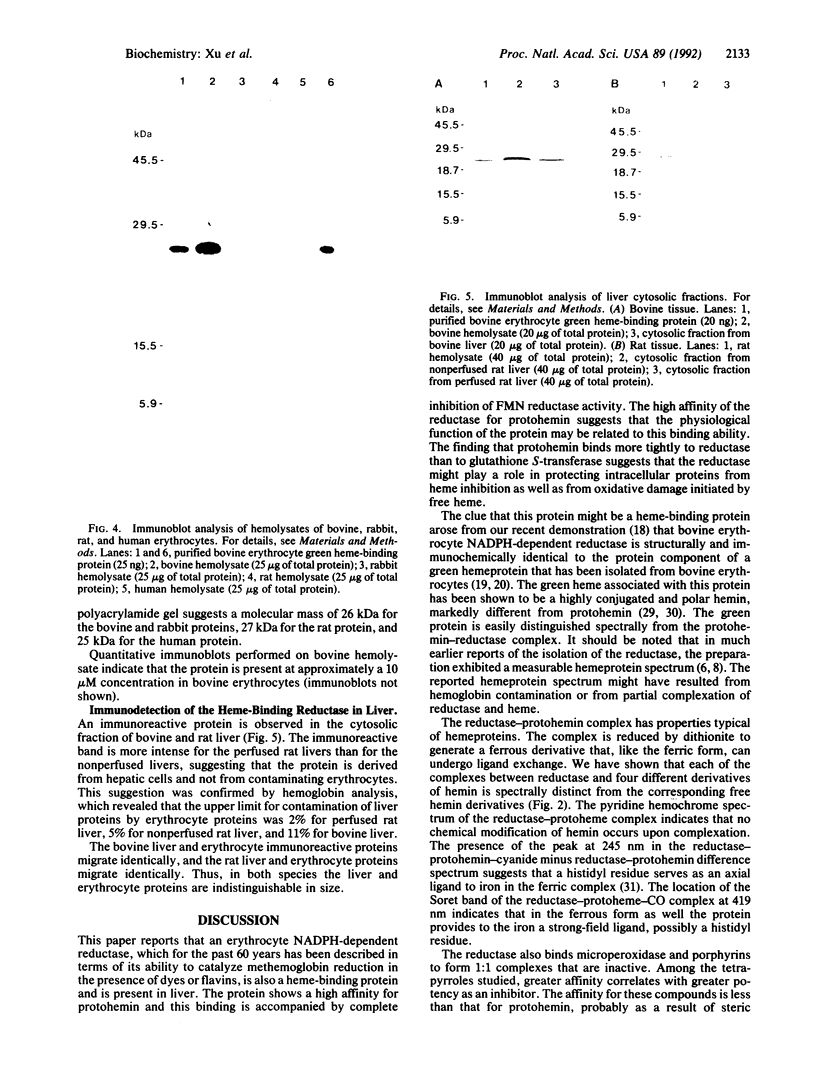Abstract
An NADPH-dependent reductase, first shown in the 1930s to catalyze the methylene blue-dependent reduction of methemoglobin in erythrocytes, has now been characterized as a high-affinity heme-binding protein and has been detected in liver. Highly purified bovine erythrocyte reductase binds protohemin to form a 1:1 complex with a Kd of 7 nM. Binding of protohemin completely inhibits reductase activity. Other tetrapyrroles and fatty acids also bind to the reductase and inhibit its activity. Protoporphyrin, hematoporphyrin, and coproporphyrin form 1:1 complexes with Kd values ranging from 1 to 5 microM. The inhibition constants for a number of saturated and unsaturated fatty acids range from 6 to 52 microM. A protein that is immunologically cross-reactive to the reductase has been detected in the cytosolic fractions of bovine and rat liver and of bovine, rat, rabbit, and human erythrocytes. By immunoblot analysis, the bovine liver and erythrocyte proteins appear identical in size, as do the rat liver and erythrocyte proteins. The concentration of the protein in bovine erythrocytes has been estimated by quantitative immunoblotting to be 10 microM. The detection of this protein in liver cells, the demonstration of its binding properties, and its weak reductase activity bring into question the long-held belief that this is uniquely an erythrocyte protein and that it functions as a reductase.
Full text
PDF




Images in this article
Selected References
These references are in PubMed. This may not be the complete list of references from this article.
- Abe Y., Ito T., Okazaki T. Purification and characterization of NADPH-dependent methemoglobin reductase from the nucleated erythrocytes of bullfrog, Rana catesbeiana. J Biochem. 1990 Aug;108(2):255–260. doi: 10.1093/oxfordjournals.jbchem.a123190. [DOI] [PubMed] [Google Scholar]
- DeFilippi L. J., Ballou D. P., Hultquist D. E. Reaction of bovine erythrocyte green hemoprotein with oxygen and hydrogen peroxide. J Biol Chem. 1979 Aug 10;254(15):6917–6923. [PubMed] [Google Scholar]
- DeFilippi L. J., Hultquist D. E. The green hemoproteins of bovine erythrocytes. I purification and characterization. J Biol Chem. 1978 May 10;253(9):2946–2953. [PubMed] [Google Scholar]
- DeFilippi L. J., Toler L. S., Hultquist D. E. Reactivities of hydroxylamine and sodium bisulphite with carbonyl-containing haems and with the prosthetic groups of the erythrocyte green haemoproteins. Biochem J. 1979 Apr 1;179(1):151–160. doi: 10.1042/bj1790151. [DOI] [PMC free article] [PubMed] [Google Scholar]
- HUENNEKENS F. M., CAFFREY R. W., BASFORD R. E., GABRIO B. W. Erythrocyte metabolism. IV. Isolation and properties of methemoglobin reductase. J Biol Chem. 1957 Jul;227(1):261–272. [PubMed] [Google Scholar]
- Hartmann A. F., Perley A. M., Barnett H. L. A STUDY OF SOME OF THE PHYSIOLOGICAL EFFECTS OF SULFANILAMIDE. II. METHEMOGLOBIN FORMATION AND ITS CONTROL. J Clin Invest. 1938 Nov;17(6):699–710. doi: 10.1172/JCI100997. [DOI] [PMC free article] [PubMed] [Google Scholar]
- Hirano M., Matsuki T., Tanishima K., Takeshita M., Shimizu S., Nagamura Y., Yoneyama Y. Congenital methaemoglobinaemia due to NADH methaemoglobin reductase deficiency: successful treatment with oral riboflavin. Br J Haematol. 1981 Mar;47(3):353–359. doi: 10.1111/j.1365-2141.1981.tb02802.x. [DOI] [PubMed] [Google Scholar]
- Horie S., Hasumi H., Takizawa N. Heme-linked spectral changes of the protein moiety of hemoproteins in the near ultraviolet region. J Biochem. 1985 Jan;97(1):281–293. doi: 10.1093/oxfordjournals.jbchem.a135052. [DOI] [PubMed] [Google Scholar]
- Hultquist D. E., Dean R. T., Reed D. W. Isolation and characterization of the unique prosthetic group of a green hemoprotein from human erythrocytes. J Biol Chem. 1976 Jul 10;251(13):3927–3932. [PubMed] [Google Scholar]
- Kaplan J. C., Chirouze M. Therapy of recessive congenital methaemoglobinaemia by oral riboflavine. Lancet. 1978 Nov 11;2(8098):1043–1044. doi: 10.1016/s0140-6736(78)92357-7. [DOI] [PubMed] [Google Scholar]
- Laemmli U. K. Cleavage of structural proteins during the assembly of the head of bacteriophage T4. Nature. 1970 Aug 15;227(5259):680–685. doi: 10.1038/227680a0. [DOI] [PubMed] [Google Scholar]
- Muller-Eberhard U., Nikkilä H. Transport of tetrapyrroles by proteins. Semin Hematol. 1989 Apr;26(2):86–104. [PubMed] [Google Scholar]
- Niethammer D., Huennekens F. M. Bound TPN as the determinant of polymorphism in methemoglobin reductase. Biochem Biophys Res Commun. 1971 Oct 15;45(2):345–350. doi: 10.1016/0006-291x(71)90824-2. [DOI] [PubMed] [Google Scholar]
- Quandt K. S., Xu F., Chen P., Hultquist D. E. Evidence that the protein components of bovine erythrocyte green heme binding protein and flavin reductase are identical. Biochem Biophys Res Commun. 1991 Jul 15;178(1):315–321. doi: 10.1016/0006-291x(91)91816-u. [DOI] [PubMed] [Google Scholar]
- Ricci G., Del Boccio G., Pennelli A., Aceto A., Whitehead E. P., Federici G. Nonequivalence of the two subunits of horse erythrocyte glutathione transferase in their reaction with sulfhydryl reagents. J Biol Chem. 1989 Apr 5;264(10):5462–5467. [PubMed] [Google Scholar]
- SCOTT E. M., DUNCAN I. W., EKSTRAND V. THE REDUCED PYRIDINE NUCLEOTIDE DEHYDROGENASES OF HUMAN ERYTHROCYTES. J Biol Chem. 1965 Jan;240:481–485. [PubMed] [Google Scholar]
- Sass M. D., Caruso C. J., Farhangi M. TPNH-methemoglobin reductase deficiency: a new red-cell enzyme defect. J Lab Clin Med. 1967 Nov;70(5):760–767. [PubMed] [Google Scholar]
- Solar I., Dulitzky J., Shaklai N. Hemin-promoted peroxidation of red cell cytoskeletal proteins. Arch Biochem Biophys. 1990 Nov 15;283(1):81–89. doi: 10.1016/0003-9861(90)90615-6. [DOI] [PubMed] [Google Scholar]
- Towbin H., Staehelin T., Gordon J. Electrophoretic transfer of proteins from polyacrylamide gels to nitrocellulose sheets: procedure and some applications. Proc Natl Acad Sci U S A. 1979 Sep;76(9):4350–4354. doi: 10.1073/pnas.76.9.4350. [DOI] [PMC free article] [PubMed] [Google Scholar]
- Vincent S. H. Oxidative effects of heme and porphyrins on proteins and lipids. Semin Hematol. 1989 Apr;26(2):105–113. [PubMed] [Google Scholar]
- Wray W., Boulikas T., Wray V. P., Hancock R. Silver staining of proteins in polyacrylamide gels. Anal Biochem. 1981 Nov 15;118(1):197–203. doi: 10.1016/0003-2697(81)90179-2. [DOI] [PubMed] [Google Scholar]
- Yubisui T., Matsuki T., Takeshita M., Yoneyama Y. Characterization of the purified NADPH-flavin reductase of human erythrocytes. J Biochem. 1979 Mar;85(3):719–728. [PubMed] [Google Scholar]
- Yubisui T., Matsuki T., Tanishima K., Takeshita M., Yoneyama Y. NADPH-flavin reductase in human erythrocytes and the reduction of methemoglobin through flavin by the enzyme. Biochem Biophys Res Commun. 1977 May 9;76(1):174–182. doi: 10.1016/0006-291x(77)91683-7. [DOI] [PubMed] [Google Scholar]
- Yubisui T., Tamura M., Takeshita M. Characterization of a second form of NADPH-flavin reductase purified from human erythrocytes. Biochem Int. 1987 Jul;15(1):1–8. [PubMed] [Google Scholar]




